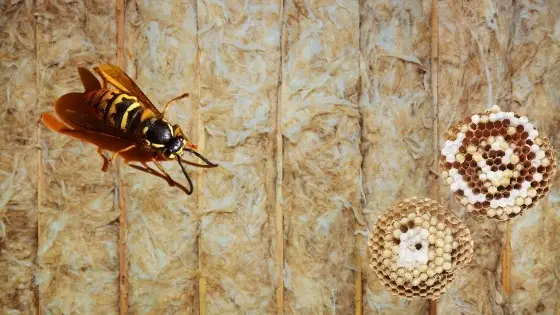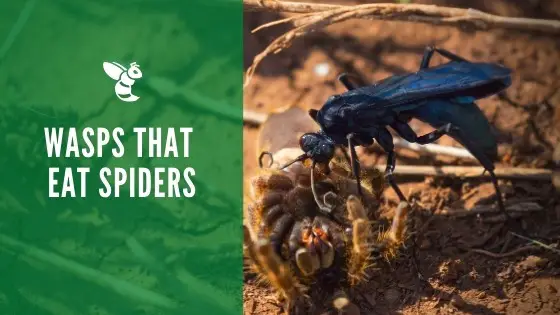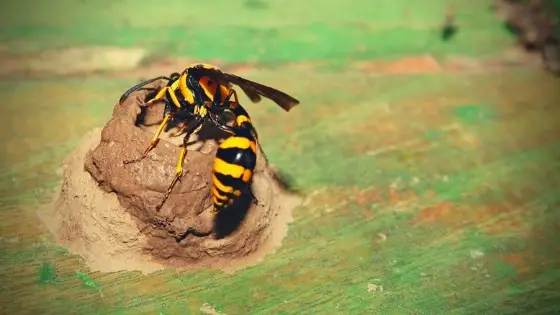Yellow Jacket Nest in Wall: How to Find and Get Rid of Them

Your typical yellow jacket colony will build their home inside of the ground, under the eaves of your house, or in the corner of your porch. However, they can be found inside the home in a number of instances. They may be looking for a warmer and safer area to establish themselves.
If you see signs of yellow jackets in your walls, this isn’t something you want to take lightly. Yellowjackets have the potential to be very aggressive, and they can sting you multiple times if they’re feeling threatened by your presence. Do you know what to look for and what to do?
How Do Yellow Jackets Get Into Your Walls?
It’s not difficult for yellow jackets to find a way into your home. Chances are, you have some sort of crack or gap around the exterior of your home. Yellowjackets and other insects don’t really need a lot of space in order to gain access. It just takes one female to gain access, and then they will start to reproduce. Before you know it, you have a major problem that requires immediate attention.
There’s no reason to become alarmed if you find one single yellow jacket inside of your home. There’s always the possibility that they gained access through an open window or when you walked through the front door that day. The front door isn’t going to be the most common way that they can get into your walls.
Your walls are typically accessible through your attic. Whether you’re attic is finished or not, this is where there is the easiest access to space between your drywall and the framing of your home. It’s less likely that this will occur if your attic floors are sealed off, creating minimal access.
What Sounds Do Yellow Jackets Make in Walls?
If you’re sitting in a quiet room and start to hear some light scratching or buzzing, you might have a yellow jacket problem in your wall nearby. Realistically, there could be a number of insects inside of that wall that are making that noise, but this is a place to start. You’ll want to start investigating further to see what’s made their home inside of your walls. If what you’re hearing is noticeable buzzing, then it’s some sort of bee or wasp problem that you have.
Yellowjacket Nest In Wall Removal
A yellow jacket problem outside can be quite a bit easier to take care of. When you’re dealing with the interior of your home, you have to be very careful with what product or process you’re using. You definitely don’t want to start spraying an insecticide inside of your walls. The smell can easily infiltrate the indoor air in your home. This is a significant health hazard.
A professional can help you quickly figure out where in the wall you’ll need to gain access. This may require a hole to be cut into the wall. When this happens, you’ll see an increase in yellow jacket activity. Be ready for them to start coming into the rest of the house. You should close all doors to bedrooms and bathrooms to prevent them from flying all over the place.
A professional will use the method of extraction to get rid of the nest, rather than using products to simply kill what’s inside the nest. The nest can get very large if it’s been there for a while.
What Does a Yellow Jacket Nest Look Like in a Wall?
A yellow jacket nest is comprised of many different layers. An established nest that’s large in size actually resembles a coil of small pods where the eggs and larvae are located. As the colony expands, more layers will be added to accommodate everyone. It will be gray or brown in color. Because the nest is inside of the wall rather than out in the open, its shape may be a little bit different as it winds around beams and wiring.
How to Keep Yellow Jackets Out of Your Walls
A few times per year, you should be walking around your property, looking for gaps and cracks that need to be sealed up. There are times of the year that yellow jackets will be working hard to find a place to build a nest. The fall months are commonly an aggressive time for yellow jackets because they know they need to get out of the cold soon in order to survive.
It’s a good idea to poke your head up into your attic a few times per year. You should be able to spot any openings based off of where there is light shining through. These areas should be properly sealed off to prevent yellow jackets and other insects from getting inside where they can build a nest.
There are also preventive products that can be sprayed outside the exterior of your home that would deter yellow jackets.



